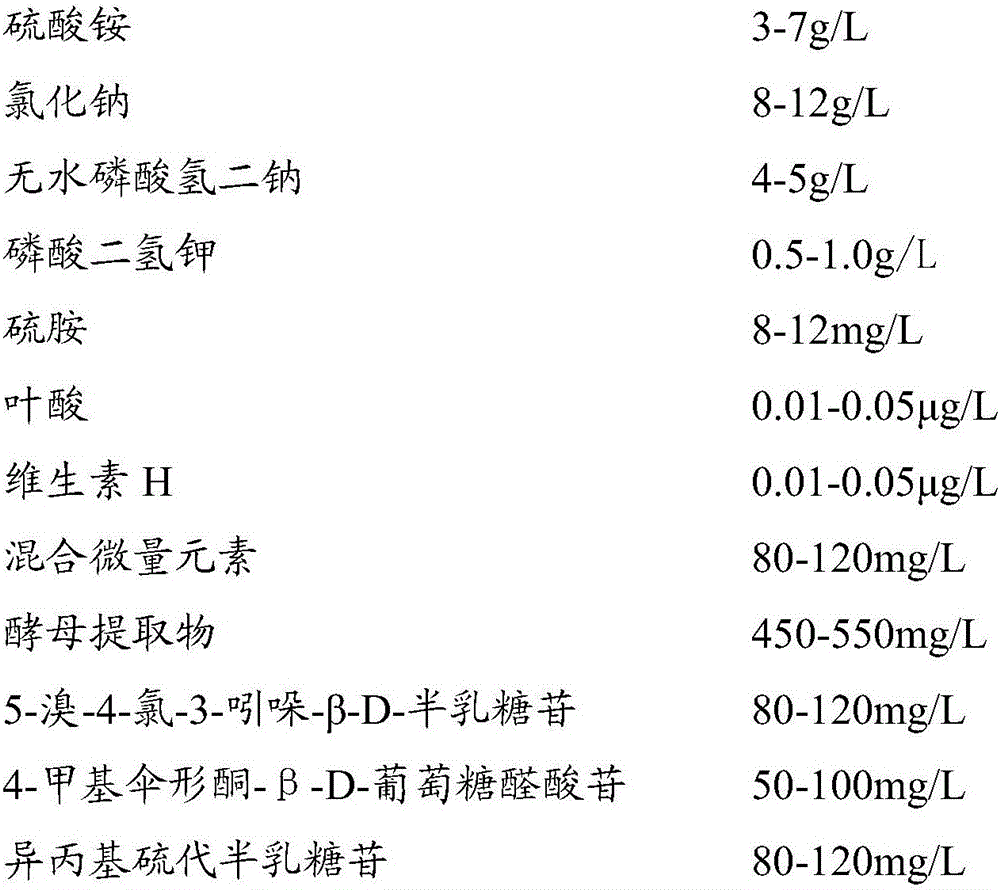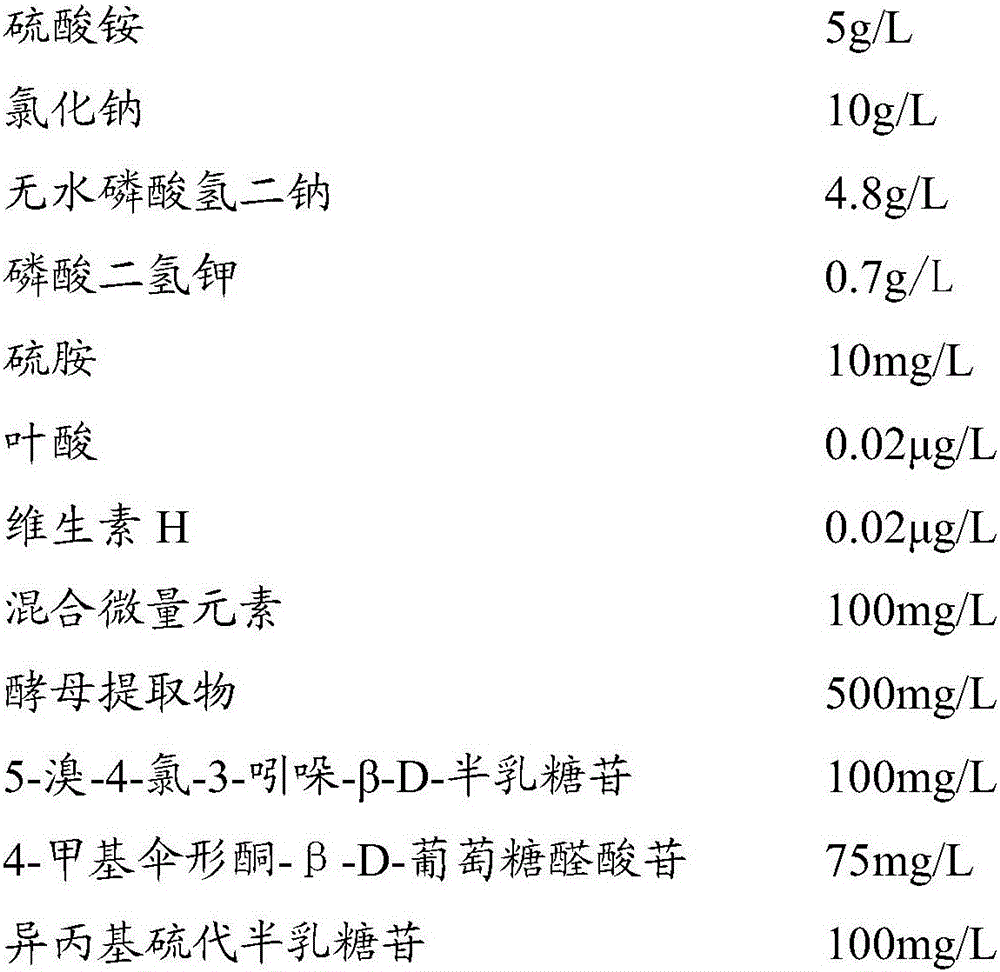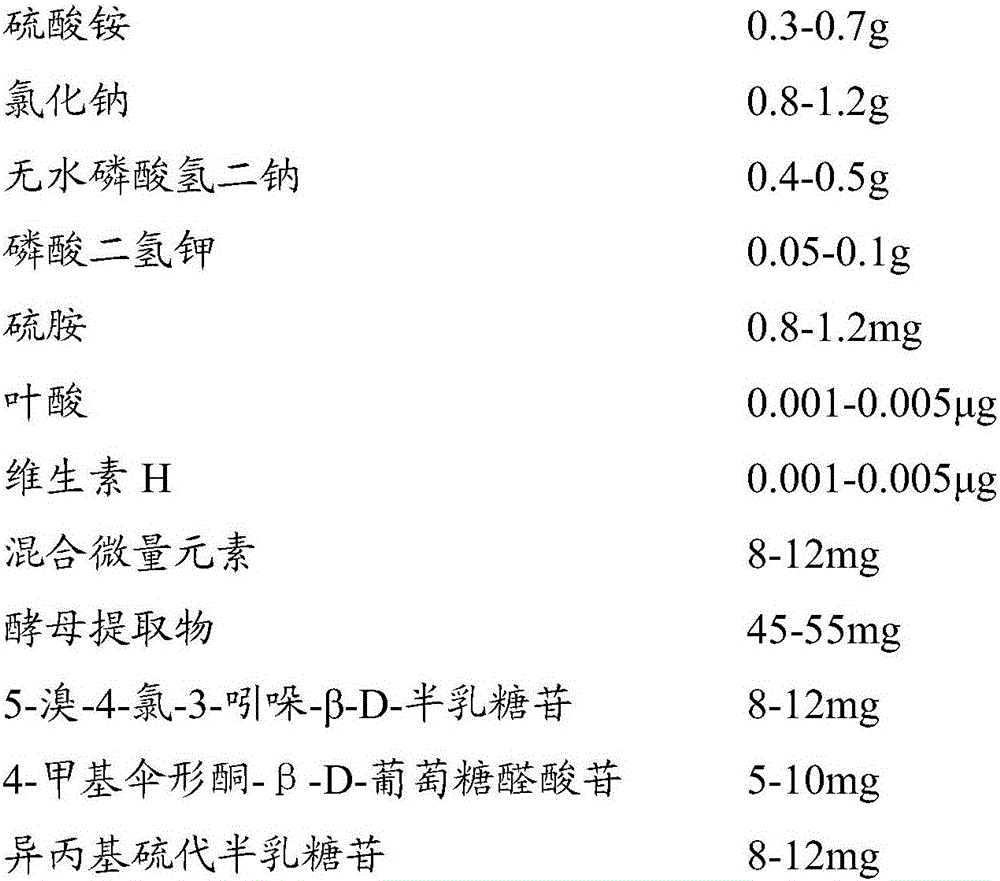Enzyme substrate culture medium capable of simultaneously detecting two fecal pollution indicator bacteria and application thereof
A medium and enzyme substrate technology, applied in microorganisms, measuring devices, biological material analysis, etc., can solve the problems of cumbersome operation steps and long detection time, and achieve the effects of simple operation, short detection time and high sensitivity
- Summary
- Abstract
- Description
- Claims
- Application Information
AI Technical Summary
Problems solved by technology
Method used
Image
Examples
Embodiment 1
[0042] Example 1 Preparation of liquid enzyme substrate culture medium capable of simultaneously detecting two kinds of feces pollution indicator bacteria
[0043] (1) Weigh each substance according to the following weights:
[0044]
[0045]
[0046] Wherein, the mixed trace elements contain: 55g of magnesium sulfate, 40g of calcium chloride, 2.5g of manganese sulfate, 2.4g of zinc sulfate, and 0.1g of copper sulfate.
[0047] (2) Dissolve the above-mentioned substances in distilled water, make up the volume to 1000L, and sterilize under high pressure.
Embodiment 2
[0048] Embodiment two can detect the preparation of the dry powder enzyme substrate culture medium of two kinds of fecal pollution indicator bacteria simultaneously
[0049] (1) Weigh each substance according to the following weights:
[0050]
[0051] Wherein, the mixed trace elements contain: 55g of magnesium sulfate, 40g of calcium chloride, 2.5g of manganese sulfate, 2.4g of zinc sulfate, and 0.1g of copper sulfate.
[0052] (2) Grind the above-mentioned substances into powder, mix well, make instant granules of 10-30 mesh at room temperature, subpackage, seal and sterilize according to the dose for testing 100mL water sample. Packed, each dose of dry powder enzyme substrate medium contains the following weights of each material:
[0053]
[0054]
[0055] Wherein, the mixed trace elements contain: 5.5 mg of magnesium sulfate, 4 mg of calcium chloride, 0.25 mg of manganese sulfate, 0.24 mg of zinc sulfate, and 0.01 mg of copper sulfate.
[0056] At room temperat...
Embodiment 3
[0057] Example 3 Qualitative detection of coliforms and Escherichia coli in water samples and comparison with conventional methods
[0058] Take 100 mL of untreated environmental water sample and place it in a sterile container with a cover of about 120 mL, add a dose of the above-mentioned dry powder enzyme substrate medium (prepared in Example 2), shake it evenly to dissolve it. Cover the container tightly and place it in an incubator at 36°C±1°C for 24h. If heat-resistant coliforms are detected, place the container in an environment of 44.5°C±1°C for 24 hours. Then observe the color change of the water sample in the container. If it is blue, it is positive for coliform or heat-resistant coliform. Observe under 366mn ultraviolet light, if there is fluorescence, it is Escherichia coli positive.
[0059] At the same time, the lactose fermentation method stipulated in the "Standard Test Methods for Drinking Water" (GB / T 5750.12-2006) was used to carry out the routine detectio...
PUM
 Login to View More
Login to View More Abstract
Description
Claims
Application Information
 Login to View More
Login to View More - R&D
- Intellectual Property
- Life Sciences
- Materials
- Tech Scout
- Unparalleled Data Quality
- Higher Quality Content
- 60% Fewer Hallucinations
Browse by: Latest US Patents, China's latest patents, Technical Efficacy Thesaurus, Application Domain, Technology Topic, Popular Technical Reports.
© 2025 PatSnap. All rights reserved.Legal|Privacy policy|Modern Slavery Act Transparency Statement|Sitemap|About US| Contact US: help@patsnap.com



